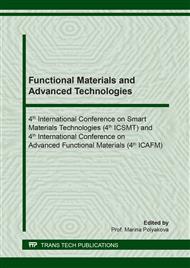p.10
p.16
p.24
p.32
p.37
p.42
p.49
p.57
p.67
Comparison of Laser Sintering of Silver Nanoparticles in Form of Microdroplets of Nanoink and Dry Nanoparticles Obtained in a Gas Discharge
Abstract:
This article presents a comparison of laser sintering of deposited nanoparticles obtained by two methods of aerosol jet printing. The first printing method was based on the use of silver nanoparticles in the form of microdroplets contained in nanoink. In the second method, dry nanoparticles were obtained as a result of gas-discharge synthesis without the use of solvents. The nanoparticles in both experiments were deposited on a glass substrate in the form of a line with a width of about 50 ± 5 μm and a height of about 1.0 ± 0.2 μm. Then, the obtained lines were sintered using laser radiation with a wavelength of 1064 nm. As a result of experiments on the deposition and sintering, it was found that the electrical resistivity of the lines of sintered nanoparticles in the form of nanoink and dry nanoparticles obtained in a gas discharge was 8.1 and 4.9 μΩ·cm, respectively. Thus, it has been demonstrated that laser sintering of nanoparticles obtained in a gas discharge makes it possible to achieve a lower specific resistance of lines than the method of aerosol printing using nanoink. In addition, the electrical resistivity of the lines of sintered nanoparticles obtained in a gas discharge is 3 times greater than the electrical resistivity of bulk silver, which is a sufficient result for the creation of conductive elements of printed electronics.
Info:
Periodical:
Pages:
37-41
Citation:
Online since:
March 2020
Keywords:
Price:
Сopyright:
© 2020 Trans Tech Publications Ltd. All Rights Reserved
Share:
Citation:


